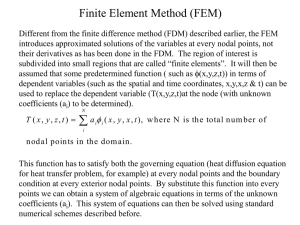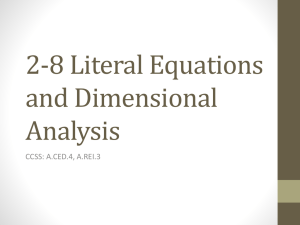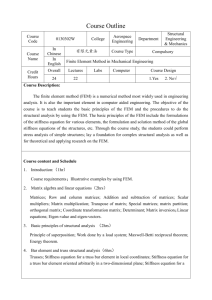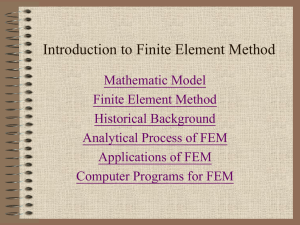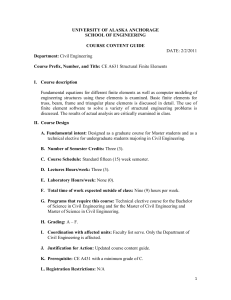finite element methods principles…
advertisement
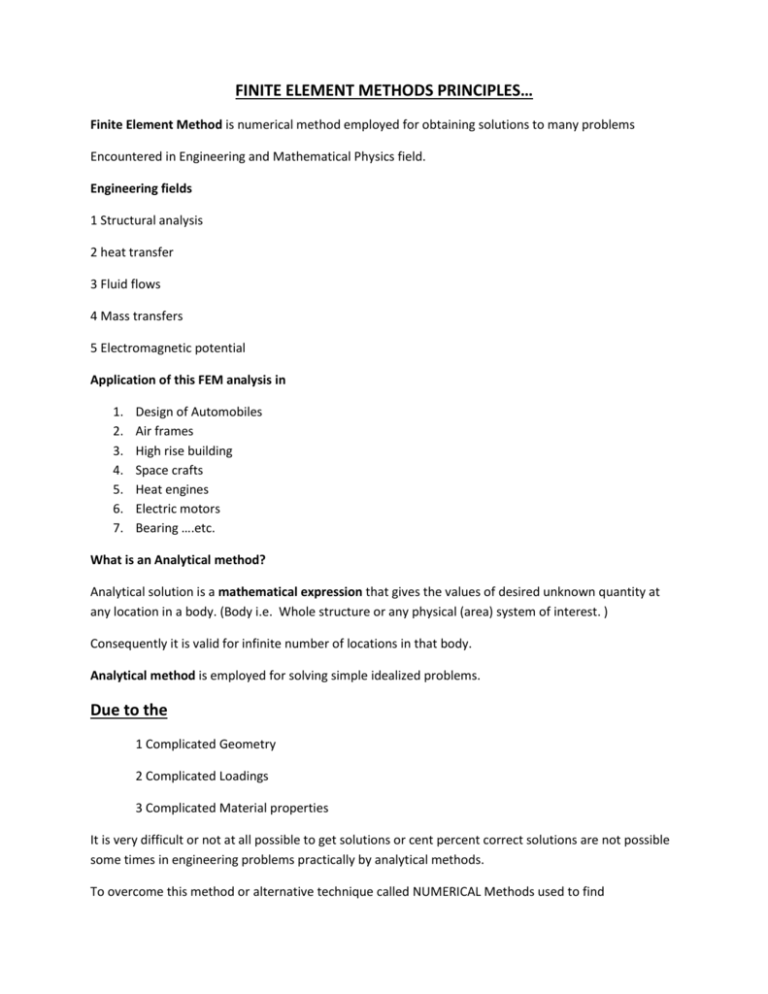
FINITE ELEMENT METHODS PRINCIPLES… Finite Element Method is numerical method employed for obtaining solutions to many problems Encountered in Engineering and Mathematical Physics field. Engineering fields 1 Structural analysis 2 heat transfer 3 Fluid flows 4 Mass transfers 5 Electromagnetic potential Application of this FEM analysis in 1. 2. 3. 4. 5. 6. 7. Design of Automobiles Air frames High rise building Space crafts Heat engines Electric motors Bearing ….etc. What is an Analytical method? Analytical solution is a mathematical expression that gives the values of desired unknown quantity at any location in a body. (Body i.e. Whole structure or any physical (area) system of interest. ) Consequently it is valid for infinite number of locations in that body. Analytical method is employed for solving simple idealized problems. Due to the 1 Complicated Geometry 2 Complicated Loadings 3 Complicated Material properties It is very difficult or not at all possible to get solutions or cent percent correct solutions are not possible some times in engineering problems practically by analytical methods. To overcome this method or alternative technique called NUMERICAL Methods used to find At least Approximate Solutions. But it is accepted solution for complicated problems arise in engineering structural analysis. Some numerical methods are 1. 2. 3. 4. 5. 6. 7. Variational method or Rayleigh –Ritz method Weighted residual methods Finite element method Finite difference method Finite volume method Power series Spectral methods and etc… The variation method and weighted residual methods generally employ differential equation for solving the problems. Finite element method makes use of polynomial expression formulated with group of simultaneous equations in solving complicated problems of engineering structures In the field of FEM technique computers are used to speed up the solution and solve very complex problem in a very short time. FEM A complex problem (region of continuing or Domain) - is discretized in to simple problems (i.e. Into simple geometric shapes or subdomains ). These spilited domains are interconnected at some critical points. Sub domains = finite elements Inter connected points = nodal points or simply nodes 1. The material properties and 2. Governing relationships’ (applied force and resultant displacement etc.) These two things are imposed on the sub domains (finite elements) and suitable simultaneous equations are formed for all elements. The solutions of these equations give the approximate behaviors of the continuum (domain) The sum of the elemental solutions will provide the required approximate solution for the whole domain or system. FEM / FEA processes involve three stages of activity 1. PREPROCESSING 2. PROCESSING 3. POST PROCESSING. PREPROCESSING - PREPRATION OF DATA (nodal co-ordinates, connectivity, boundary conditions, loading and material information) PROCESSING – STIFFNESS GENERATION, STIFFNESS MODIFICATION AND SOLUTION OF EQUATION, RESULTING IN THE EVALUATION OF NODAL VARIABLES. DERIVED QUANTITIES LIKE GRADIENTS OR STRESSES EVALUATED. POST PROCESSING - PRESENTATION OF RESULTS. DEFORMED CONFIGUATION, STRESS DISTRIBUTIONS, TEMPERATURES ETC. ARE COMPUTED AND DISPLAYED. BASIC STEPS OF 1 2 3 4 5 6 7 8 FEM Discretization of the structure Selection of Displacement function Formation of the element stiffness matrix and load vector Formation of Global stiffness matrix and load vector Incorporation of Boundary conditions Solution of Simultaneous equations Calculation of element strains and stresses Interpretation of the result obtained. Discretization or Finite element zing and their type 1. Based on Dimension 2. Based on Material Property 3. Based on Degree of Freedom 1 Based on Dimension One dimensional element - line element , two dimensional element – Triangular and quadrilateral, three dimensional elements - Tetrahedral and hexahedral elements 2 Based on Material Property Linear element , non linear element 3 Based on Degree of Freedom Translational - one or two or three degree of freedom Rotational - one or two or three degree of freedom. Category of finite elements Simple , complex and multiple elements The order of polynomial used in interpolation function decided by the geometry of the element For Simple elements - Interpolation function contains only constant and linear terms only. Ie. Approximating polynomial expression has only constant and linear terms in simplex element. So they are called linear elements. The elements specified for n=1 single order polynomial for one two and three dimensional elements. The simplex element of one dimensional is a line with two nodes at the ends 4 one dimensional Line element Two Dimensional( triangular element) 3 1 3 2 axially loaded long bar truss 2 2 1 2 Three dim1ensional ( tetra hedran ) Triangular (quadrilateral ) Temperature distribution in rod and the pressure distribution in pipe flow are one dimensional problems. The plates under biaxial loading 1 3 1



